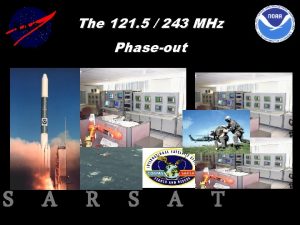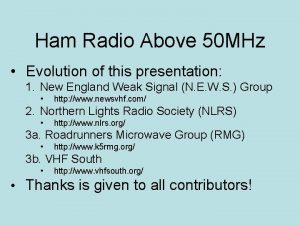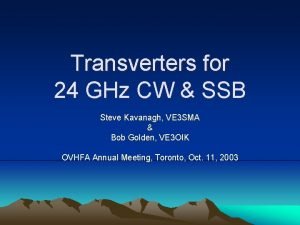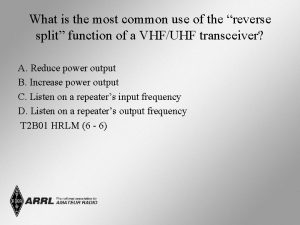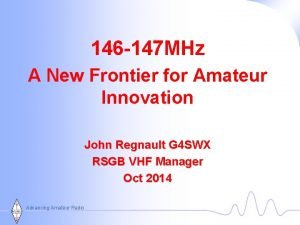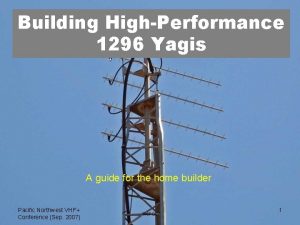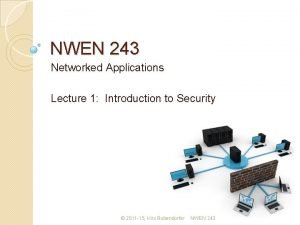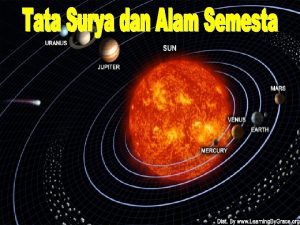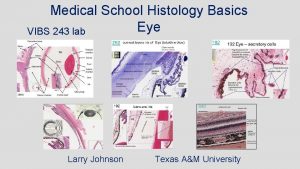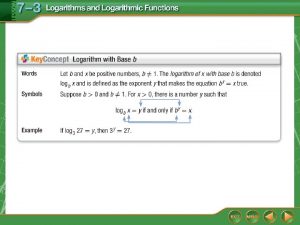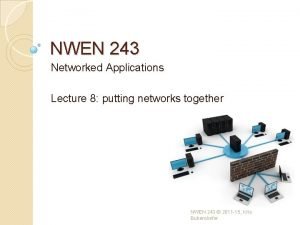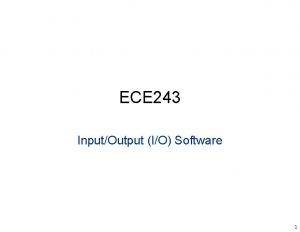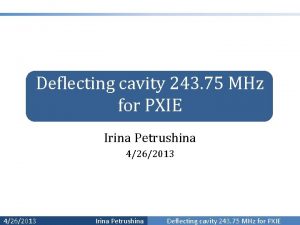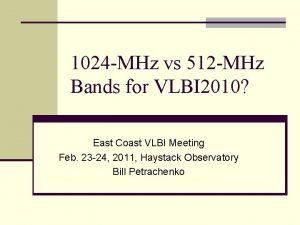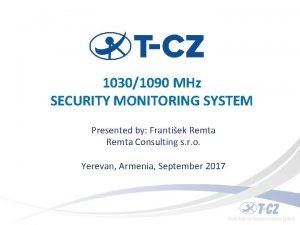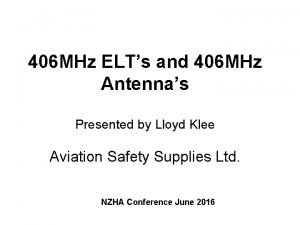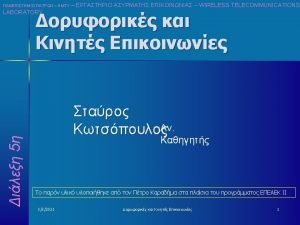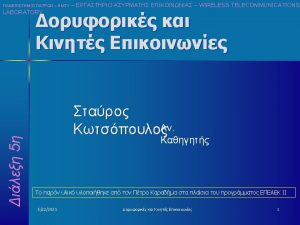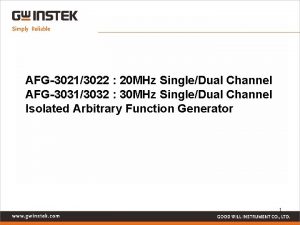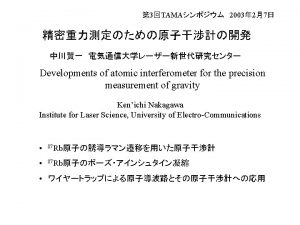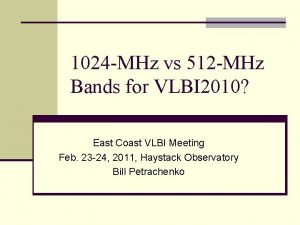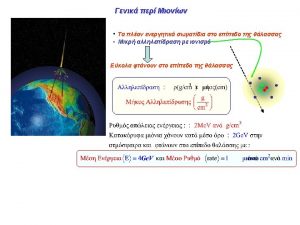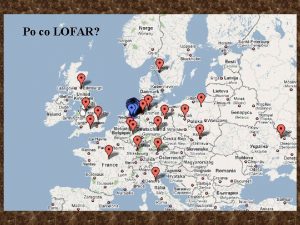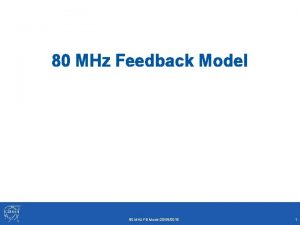The 121 5 243 MHz Phaseout S A





























- Slides: 29

The 121. 5 / 243 MHz Phase-out S A R S A T

Overview - 121. 5/243 MHz Beacon Technology - Limitations - International Cospas-Sarsat Council Decision - National 121. 5/243 MHz Phaseout Plan


Emergency Beacons • Two types: 121. 5/243 MHz and 406 MHz • Three applications: - Emergency Position Indication Radio Beacons (EPIRB) for Maritime Uses - Emergency Locator Transmitters (ELT) for Aviation Uses - Personal Locator Beacons (PLB) for Remote Recreational Uses

121. 5 MHz Beacon Technology – Brief Background • First 121. 5 MHz beacons were ELTs designed for military aircraft in the 1950’s. • Congress mandated ELTs on all U. S. aircraft after Boggs-Begich tragedy in SE Alaska in 1970’s. • Cospas-Sarsat was designed to use the existing 121. 5 MHz technology with an eye towards developing a digital system. • Why? - 121. 5 was not designed for satellite processing (no store & forward capability)

Limitations of 121. 5 / 243 MHz Beacons… • Analog signal only = no digital identification code to let SARSAT system know signal is from a beacon • Low power output…hard for satellites to detect • Less rigid standards • USMCC handles 250 -400 “hits” per day: - Only 1 in 8 alerts come from beacons. The rest are interference sources like ATM machines, pizza ovens, and even stadium scoreboards! • High false alert rate makes first-alert launch unfeasible…delays SAR response to possible victims.

Limitations of 121. 5 / 243 MHz Beacons… Limitations with satellites • ‘Bent-Pipe’ mode on = no global coverage • No store & forward capability

Limitations (con’t): No Global Coverage

406 MHz is a Store & Forward System

406 MHz has Global Coverage and Instantaneous Detection! GEO Footprint LEO Footprint

Limitations of 121. 5 / 243 MHz Beacons… …Poorer Accuracy 406 MHz with GPS 406 MHz 121. 5 MHz Search Time = Minimal Search Time = 2 - 3 hours Search Time = 12+ hours

243 MHz Beacons • Similar to 121. 5 MHz beacons • Primarily used by the military • Many existing 121. 5 MHz also transmit on 243 MHz • Will Not Be Detected by Satellites After February 1, 2009!

*** 121. 5/243 MHz PHASE-OUT DECISION *** International Cospas-Sarsat Council (in conjuction with IMO& ICAO) announces at its 25 th General Session (October 2000) that the termination of 121. 5 & 243 MHz for satellite alerting will occur on… February 1, 2009

This decision leads to the development of a National 121. 5/243 MHz Phase Out Plan Goal: To efficiently transition all users away from 121. 5 MHz satellite alerting and associated distress beacon usage to the exclusive use of 406 MHz alerting and corresponding 406 MHz distress beacons…. …and to do so in advance of February 01, 2009! IMPLEMENTATION: The Five “W”s…and the one “H”! • WHO • WHAT • WHERE • WHEN • WHY …and HOW ?

WHY Develop a National Plan? ? ? • To organize transition at all levels • To coordinate transition among involved parties • To minimize impact of terminating 121. 5 MHz alerting • To prepare for increased 406 MHz usage and response

WHERE To Implement the Plan? • The plan should be implemented at all levels: – Local – National – Regional – Global

WHEN…. . Development & Implementation • Plan Development has already begun • Plan Implementation: – Initial efforts have already commenced – National 121. 5 MHz Phase-Out Working Group (POWG) • Created by NSARC • POWG Terms of Reference…

Terms of Reference for a National 121. 5/243 MHz Satellite Alerting Phase-Out Working Group The National Search and Rescue Committee (NSARC), • Recognizing the impending Cospas-Sarsat termination date for 121. 5/243 MHz satellite distress alerting on 01 February 2009; • Considering the importance of the need to develop a national coordinated plan to address all pertinent phase-out issues associated with 121. 5/243 MHz termination; • Addressing the recommendations from the Cospas-Sarsat Council to develop a national plan for the transition from 121. 5/243 MHz to 406 MHz beacons; establishes the National 121. 5/243 MHz Satellite Alerting Phase-Out Working Group. The Working Group is tasked to: 1. develop a comprehensive national strategy, including a working plan and schedule, for implementing the phase-out of 121. 5/243 MHz satellite alerting by 01 February, 2009; 2. address and prioritize the technical aspects and impacts associated with phase-out, including beacon issues, satellite issues, and ground segment issues; 3. address and prioritize the regulatory aspects and impacts associated with phase-out, including what legislative options are available for eliminating 121. 5/243 MHz beacons and mandating the use of 406 MHz beacons; 4. address and prioritize the educational aspects and impacts associated with phase-out, including the use of appropriate media to publicize this effort, and; 5. develop guidelines on the proper disposal of old beacons to prevent an unwanted increase in false alerts. The Phase-Out Working Group (POWG) shall be comprised of member agencies of the U. S. National Search and Rescue Committee and relevant organizations and equipment manufacturers who can fruitfully contribute to achieving the tasks hereto assigned and shall meet in a timely manner for their proper implementation.

WHAT are the key issues? • Cospas-Sarsat system transition within the U. S. – Includes ground and space segments • Impact on U. S. SAR system – Elimination of 121. 5 MHz false alerts – 121. 5 MHz alerting system reversion to 1970 s “high flyer” alerting – Increase in 406 beacon population / activations / false alerts • Benefit of transition for U. S. public, SAR responders & others – 406 MHz Beacon registration - SAR response & false alert mitigation – Proper & Easy To Follow 406 MHz EPIRB/ELT/PLB Testing Programs • Regulations/Legislation Changes – ELTs / EPIRBs / PLBs MORE…

WHAT are the key issues? • How de we get the word out? ? ? • Cost – Current comparable cost – Anticipated future cost reductions – Low Cost Beacons? !? !

WHO is Leading the Transition? • NSARC - National Search and Rescue Committee DOC S Sa ARSA tel lite T Le Se ad, rvi (NO ce s AA ) SA ( SAR Lead/Facilities DOD FCC t’l Na ark DOI Se P Research and Development (USAF & DPMO) dio y a R nc r o f ue s q ion Fre t a ul es & ues g Re ciliti Iss Fa es c i e) erv c S i rv R FA SA R Re Le NASA ad /R US CG egs g A s DOT DHS

WHO is Coordinating the Transition • United States Cospas-Sarsat Program Inland SAR Maritime SAR Satellite Integration / Post Launch Testing Space Hardware Research & Development System Operation Ground Segment Lead Agency to the Cospas-Sarsat Program

WHO is Impacted? • Everyone! • Primary Impact – Beacon Users – SAR Response Agencies WHO Needs to be Involved in The Transition? • Government – Federal / State Regulators – Federal / State SAR Responder • Public – Recreational Vessels – General Aviation • Beacon Manufacturers • Industry - Aviation / Maritime – Aircraft Manufacturers – Charter Vessel Companies – Commercial Fishing Industry • Special Interest Groups – Maritime (e. g. , Boat. US) – Aviation (e. g. , AOPA, EAA)

WHO Needs to be Kept Informed? International Maritime Organization International Civil Aviation Organization International Telecommunication Union Cospas-Sarsat Participants Other Nations Within / Bordering U. S. SAR Region

HOW Do We Accomplish The Transition? • PROMOTE - Public Events, Online, Public Service Announcements, Retail Outlets, Word-of-Mouth…etc, etc. – Phase-out of 121. 5 MHz Satellite Alerting – Benefits of transitioning to 406 MHz Beacons • EDUCATE - As Above, Public Safety Courses, Agency Training – Beacon owners - need to transition to 406 MHz beacons - proper use of 406 MHz beacons – SAR Responders - Effectiveness of the 406 MHz system - Capabilities of 406 MHz beacons • REGULATE ( LEGISLATE) – Stoppage of 121. 5 MHz beacon use (EPIRBs & ELTs) – Use of 406 MHz beacons (EPIRBs, ELTs & PLBs)

HOW To Regulate? • 121. 5 MHz BEACON USAGE – International Termination of 121. 5 MHz Satellite Alerting = 01 February 2009! – U. S. Termination of 121. 5 MHz EPIRBs = 3 Phases • Certification of new 121. 5 EPIRBs ceased • Sales and manufacture of 121. 5 MHz EPIRBs ceased on 01 February, 2003 • Operation/Use of 121. 5 MHz EPIRBs becomes illegal on 01 January, 2007 – 121. 5 MHz ELTs will still be in use and required on general aviation aircraft…must get pilots to transition ASAP!

HOW To Regulate? • 406 MHz BEACON USAGE (EPIRBs, ELTs & PLBs) – 406 MHz EPIRBs required by law on certain U. S. vessels • Commercial fishing vessels • SOLAS-class vessels • Large passenger carrying vessels – 406 MHz ELTs • Cited & recommended as option to required 121. 5 MHz ELTs • Required on new commercial passenger aircraft on int’l flights as of 2002 • Required on all commercial passenger aircraft on international flights as of 2005 – 406 MHz PLBs • Allowed for sale and use in the U. S. as of 01 July 2003 • 121. 5 homer limited to a maximum 25 mw output • Morse Code “P” embedded in beacon transmission

HOW To Regulate?

Any Questions? ? ? FOR MORE INFO… NOAA/SARSAT E/SP 3, Room 3320, FB 4 5200 Auth Road Suitland, MD 20746 1 -301 -457 -5678 x 114 Or 1 -888 -212 -7283 x 114 Fax: 1 -301 -457 -5620 Visit Our Website! www. sarsat. noaa. gov
 121,5 mhz
121,5 mhz Plate 160m series ftv
Plate 160m series ftv Wz1v beacon list
Wz1v beacon list 24 ghz transverter
24 ghz transverter Where may ssb phone be used in amateur bands above 50 mhz?
Where may ssb phone be used in amateur bands above 50 mhz? 147 mhz
147 mhz 25 mhz band
25 mhz band A benchmark program is run on a 40 mhz processor
A benchmark program is run on a 40 mhz processor G3jvl loop yagi
G3jvl loop yagi 248 kpk
248 kpk Nilai dari ³log 9 + ³log27 adalah
Nilai dari ³log 9 + ³log27 adalah Nwen243
Nwen243 Kod jednoznaczny
Kod jednoznaczny 243 ida
243 ida Przedszkole nr 243
Przedszkole nr 243 Vibs histology
Vibs histology Article 243x
Article 243x Cs 243
Cs 243 Suku ke 5 dari barisan geometri adalah 243
Suku ke 5 dari barisan geometri adalah 243 Przedszkole nr 243
Przedszkole nr 243 Viaggio di telemaco
Viaggio di telemaco Jika log 2 = 0 301 dan log 3 = 0 477
Jika log 2 = 0 301 dan log 3 = 0 477 243 p
243 p Vibs histology
Vibs histology Akar pangkat dari 674
Akar pangkat dari 674 Log3 9=2 in exponential form
Log3 9=2 in exponential form Nwen243
Nwen243 điện thế nghỉ
điện thế nghỉ Biện pháp chống mỏi cơ
Biện pháp chống mỏi cơ Trời xanh đây là của chúng ta thể thơ
Trời xanh đây là của chúng ta thể thơ
